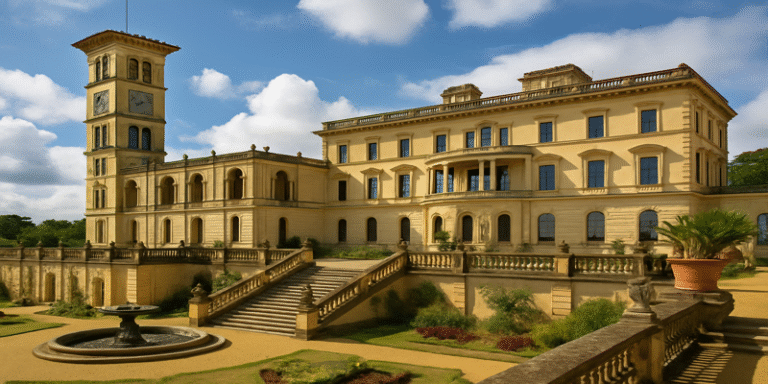Set against the sweeping views of the Solent on the Isle of Wight, Osborne House invites visitors on an immersive journey into royal heritage, architectural grandeur, and Victorian elegance. Once the cherished private residence of Queen Victoria and Prince Albert, Osborne now serves as a unique and powerful tourist destination, offering both historical richness and picturesque beauty. From opulent interiors to tranquil gardens and a private beach, Osborne House blends regal nostalgia with the leisurely pleasures of island tourism.
A Royal Retreat by the Sea
Built in the Italianate style between 1845 and 1851, Osborne House was designed as a retreat away from public life for the royal family. Prince Albert played a key role in its architecture, drawing inspiration from classical Italian villas and aiming to create a serene family environment (Twyman, 2010). The house became not just a royal residence but a deeply personal space for the Queen, who remarked that it was “impossible to imagine a prettier spot” (Baudouin & Harris, 2021).
The house became a symbolic location of domestic royal life. Queen Victoria spent much of her time there, and it was at Osborne where she passed away in 1901. Her long reign and personal connection to the property imbued it with cultural weight and enduring significance.
A Jewel in Britain’s Heritage Tourism
Today, Osborne House stands as one of the most visited historic sites on the Isle of Wight and is maintained by English Heritage, which has transformed it into a hub for heritage tourism (Clark, 2008). With its lavish drawing rooms, preserved royal bedrooms, and the famous Durbar Room—a stunning tribute to British India—the house offers a compelling glimpse into the workings of 19th-century monarchy and empire (Palmor, 2015).
Heritage tourism is a powerful economic and cultural force. As Munt (2016) notes, the Isle of Wight uses such sites to diversify its tourism base, blending natural coastal attractions with historical and cultural experiences. Osborne House sits at the centre of this strategy, acting as a draw for international and domestic visitors alike.
Exploring the Grounds: Gardens, Swiss Cottage and Private Beach
Beyond the mansion, Osborne’s grounds are a significant part of the visitor experience. Spanning over 350 acres, the estate includes formal gardens, woodland walks, and Victorian terraces filled with Mediterranean plants that reflect Prince Albert’s passion for landscape design (Lloyd & Pevsner, 2006).
Of particular interest is the Swiss Cottage, a playhouse built for the royal children, where they engaged in gardening, cooking, and role-playing activities. Visitors today can walk through the same paths and enjoy exhibitions displaying the toys, clothes, and schoolbooks of royal youth.
Nearby is Osborne’s private beach, opened to the public in recent years. The Queen herself swam here, and the rustic bathing machine used by her is still on display. The beach offers a serene environment and provides visitors with a rare chance to walk where royalty once paddled.
Living History: Events and Experiences
A significant part of Osborne’s charm is the immersive visitor experience. Seasonal events such as Victorian reenactments, royal garden parties, and educational programmes make the house a living museum. English Heritage has effectively utilised the site to blend historical education with entertainment.
Gill (2017) notes that such dynamic programming is vital in keeping heritage sites relevant in the modern tourism landscape, particularly for younger audiences who seek interactivity over static displays. At Osborne, history is not just observed—it’s lived.
Architecture and Imperial Imagery
Perhaps one of the most fascinating aspects of Osborne House is how it encapsulates Victorian identity and the symbolism of empire. The Durbar Room, designed in 1890, is filled with Indian architectural motifs, gifts from the Queen’s Indian attendants, and intricate carvings by Indian artisans. The room reflects Queen Victoria’s status as Empress of India, reinforcing how imperial narratives were woven into personal and domestic spaces (Rodger, 2019).
This use of architecture for imperial display aligns with Baudouin and Harris’s (2021) observation that royal residences were often used to project an image of monarchy that was both familial and global. Osborne House, in this way, acts as a stage for Britain’s 19th-century geopolitical identity.
Accessibility and Sustainability
Osborne is well-connected via ferry from Southampton and Portsmouth, and it forms a key stop on the Victoria’s Island Trail—a tourism initiative promoting sites linked to Queen Victoria across the Isle of Wight (Visit Isle of Wight, 2024).
Efforts have also been made to ensure environmental sustainability in the management of the estate. Groundskeeping now incorporates eco-friendly practices, and English Heritage has installed electric shuttle transport around the grounds to reduce emissions and support accessibility for all visitors.
Osborne in Literature and Culture
The romanticism of Osborne House has long fascinated writers, filmmakers, and cultural historians. It featured prominently in the film Victoria and Abdul (2017), where the Durbar Room and seaside views became visual metaphors for Queen Victoria’s complex relationship with her empire and legacy.
The house has also been referenced in numerous travel journals, historical biographies, and tourism guides. Turner (2023) highlights Osborne as one of the top destinations on the island for cultural and literary tourism, while Kendall (2022) connects the site to wider discussions on British identity and royal nostalgia.
Why Osborne Still Matters
In a world increasingly drawn to fast-paced experiences and digital stimulation, Osborne House offers a rare moment of tranquillity and reflection. It remains one of the few places where the private life of a public monarch is laid bare in a setting of architectural beauty and historical depth.
For tourists seeking not just relaxation but enrichment, Osborne House is more than a day trip—it’s a journey into the soul of the Victorian era. It reminds us how the lives of historical figures were shaped by the places they called home—and how those places continue to shape our understanding of the past.
Whether you’re a history enthusiast, a fan of royal drama, or simply someone looking for a beautiful corner of the Isle of Wight, Osborne House delivers an unforgettable experience. As a heritage site, it is a powerful representation of Queen Victoria’s reign, her personal story, and the era she defined.
Its continued appeal demonstrates how well-maintained heritage tourism can serve both education and entertainment while contributing meaningfully to local economies and cultural preservation.
References
Baudouin, S. and Harris, T. (2021). The Making and Promotion of Scottishness in Eighteenth and Nineteenth-Century Britain: Sir Walter Scott, Queen Victoria and Tourism. [online] ResearchGate. Available at: https://www.researchgate.net/publication/347984169.
Clark, K. (2008). Valuing the Heritage of the Channel Islands. Government of Jersey. Available at: http://www.gov.je.
Gill, D.W.J. (2017). The Ministry of Works and the Development of Souvenir Guides from 1955. Public Archaeology, [online] Available at: https://oars.uos.ac.uk.
Lloyd, D. and Pevsner, N. (2006). The Isle of Wight. Yale University Press.
Munt, M.C. (2016). ‘Geoheritage Case Study: The Isle of Wight, England’. In: T. Hose, ed., Geotourism. A European Perspective. London: Elsevier.
Palmor, L. (2015). Queen Victoria’s Durbar Room: The Imperial Museum at Home. Scholaris University of Toronto.
Rodger, R. (2019). Queen Victoria, Edinburgh, and a Sense of Place. ResearchGate. Available at: https://www.researchgate.net.
Turner, W. (2023). A-Z of the Isle of Wight: Places, People, History. Amberley Publishing.
Visit Isle of Wight (2024). Victoria’s Island Trail. [online] Available at: https://www.visitisleofwight.co.uk.









